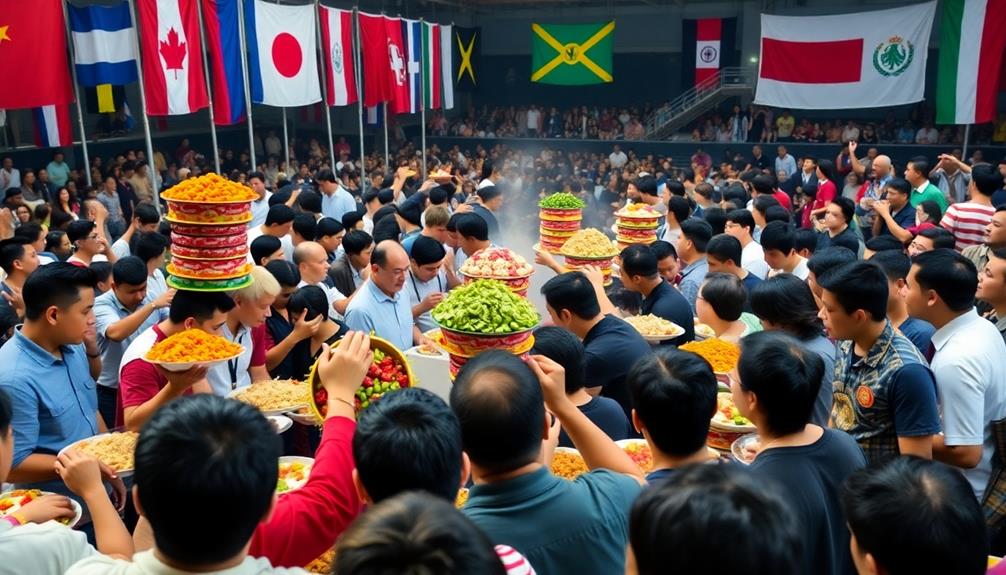Competitive eating isn't just an odd show; it taps into psychological drivers and cultural themes. You'll see how it reflects society's obsession with abundance and consumerism. Famous events like Nathan's Hot Dog Contest highlight this spectacle, drawing massive crowds and media attention. Competitors, like Joey Chestnut, push their limits, converting food into a competitive challenge. Yet, health risks loom in the background, raising ethical questions about sustainability and food waste. Understanding these elements reveals more than what's on the plate—it's about what it signifies in our culture. There's plenty more to explore about this fascinating trend.
Key Takeaways
- Competitive eating reflects American consumerism, showcasing society's fascination with abundance and excess during events like Nathan's Hot Dog Contest.
- The sport's evolution from informal contests to organized events highlights individual performance and the celebration of remarkable achievements.
- Media portrayal of competitive eaters as "Celebrity Consumers" reinforces cultural values of indulgence, increasing public interest and participation in these events.
- Gender dynamics influence consumption behavior, with male competitors consuming more food due to social encouragement, while females face self-consciousness and societal pressures.
- Ethical concerns arise regarding food waste and health risks, prompting discussions on responsible consumption and the long-term nutritional impact of competitive eating.
Origins of Competitive Eating
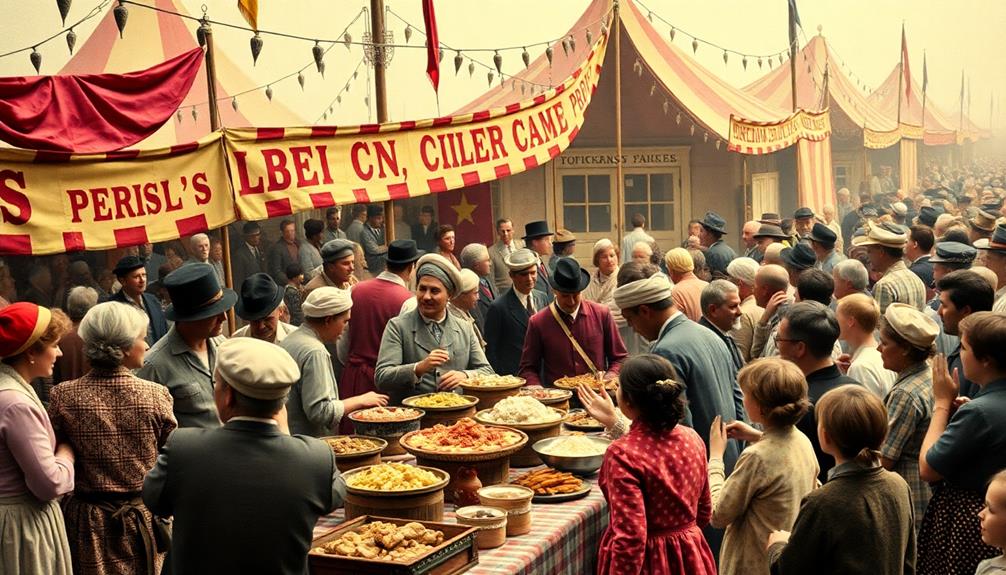
Emerging in Japan during the 1990s, competitive eating began to gain traction alongside the popularity of cooking shows like *Iron Chef*. This burgeoning sport found its way to America and connected deeply with traditional American culture, particularly through events like the Nathan's Famous Hot Dog Contest.
Starting as a local event in 1916, the contest gained national recognition in the 1990s, thanks to the promotional efforts of publicists George and Richard Shea. Notably, food traditions around the world, such as Muamba De Galinha in Angola, highlight the cultural significance of communal eating experiences.
The sport really took off in 2001 when Takeru Kobayashi set a record by consuming 50 hot dogs, creating a buzz that captured public interest. This moment marked a significant turning point, leading to a wave of competitors enthusiastic to challenge that benchmark. Joey Chestnut later surpassed Kobayashi's record by eating 69 hot dogs in 2013, further solidifying competitive eating's place in American culture.
While competitive eating may have evolved from informal contests, its origins are rooted in historical pie-eating contests at American county fairs, dating back to the 17th century.
Today, it stands as an organized sport with formal rules, emphasizing individual performance and record-setting.
Cultural Reflections of Excess
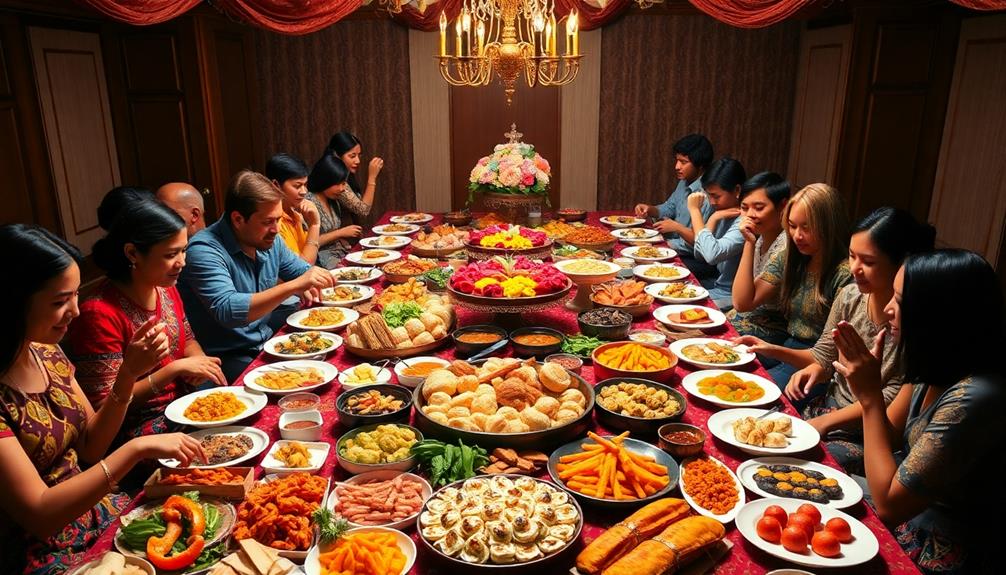
Competitive eating acts as a vivid reflection of American culture, showcasing a fascination with abundance and consumerism. Events like Nathan's Hot Dog Contest draw massive crowds and millions of TV viewers, serving not just as competitions but as spectacles of excess.
In this culinary landscape, you might also find creative food presentations that capture the festive spirit of gatherings, such as Graveyard Taco Dip, which mirrors the playful indulgence of competitive eating. You see, participants often become "Celebrity Consumers," embodying society's celebration of indulgence and overconsumption.
The media coverage surrounding these events, including ESPN broadcasts and documentaries, plays an essential role in shaping how you perceive food consumption. It transforms eating into a thrilling spectacle, reinforcing ideas of excess in popular culture.
Competitive eating isn't merely about food; it's a performance that juxtaposes gluttony with entertainment, challenging traditional food norms. As you engage with this phenomenon, you might notice it reflects broader societal trends towards individualism amid overwhelming consumer forces.
The struggle for identity manifests in the competitive arena, turning consumption into a sport. Ultimately, competitive eating encapsulates the complexities of contemporary consumption patterns, highlighting how society celebrates, critiques, and even commodifies excess.
Profiles of Competitive Eaters

The world of competitive eating features a diverse range of personalities, each with unique backgrounds and strategies that contribute to their success.
Take Joey Chestnut, for example; standing 6 feet tall and weighing 225 pounds, he's the dominant figure in the sport, with over $200,000 in career earnings and a staggering record of 69 hot dogs consumed in 2013. Known for their impressive appetites, competitive eaters often train with various types of cuisine, including dishes like Mushroom Masala, which showcases the rich blend of spices that can enhance one's culinary experience.
Then there's Sonya Thomas, affectionately known as "The Black Widow." Weighing just 100 pounds, she manages a Burger King while holding the women's record with 45 hot dogs.
Takeru Kobayashi, weighing only 105 pounds, revolutionized the game by incorporating weightlifting into his training, leading to a record of 50 hot dogs in 2001.
Additionally, competitors like Jason "Crazy Legs" Conti adopt unique strategies to enhance their performance in eating competitions. Additionally, competitors like Jason “Crazy Legs” Conti adopt unique strategies to enhance their performance in eating competitions. Conti is known for his ability to stay calm under pressure, often employing controlled breathing techniques to maintain his pace. Much like actors who double as musicians juggle two distinct skill sets, Conti seamlessly blends mental focus with physical endurance, making him a formidable force in the competitive eating world.
Regardless of their individual approaches, competitive eaters generally view food as an obstacle rather than sustenance, driven by dedication and the desire to achieve remarkable feats in Professional Competitive Eating.
Their diverse backgrounds and strategies make this sport not only fascinating but a demonstration of human determination.
Media Influence and Public Perception

In recent years, media coverage has transformed competitive eating from a niche pastime into a widely recognized spectacle. Major networks like ESPN have vastly increased visibility for events such as Nathan's Hot Dog Contest, attracting millions of viewers and raising public perceptions of this unique sport.
You might notice how competitive eaters are often portrayed as "Celebrity Consumers," reflecting American values of abundance and consumerism. This fascination with excess is echoed in various cultural expressions, such as the rich flavors of Red-Braised Pork Belly, which showcases the importance of indulgence in culinary traditions.
Here are three key points illustrating this media influence:
- Cultural Fascination: Events draw over 40,000 spectators and nearly 2 million television viewers, showcasing society's obsession with excess.
- Patriotic Framing: The portrayal of these contests often evokes a sense of national pride, further influencing public interest and participation.
- Ethical Questions: As competitive eating gains popularity, it raises ethical concerns about food waste and health implications, prompting debate on societal norms regarding consumption.
These dynamics highlight how competitive eating contests not only entertain but also challenge our understanding of food in a consumer-driven society. They force us to confront indulgence and excess, prompting reflection on our cultural relationship with consumption and abundance. Much like the psychology behind buffet food choices, these events reveal how environmental cues and social settings can influence eating behavior and decision-making. Ultimately, they blur the lines between sustenance and spectacle, catering to both fascination and critique.
Health Risks and Nutrition Concerns
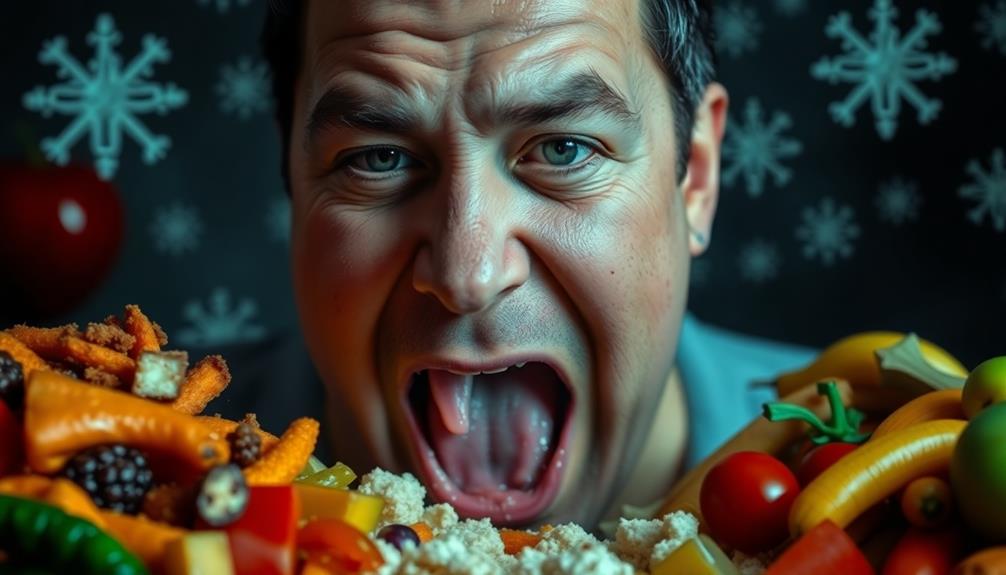
When you participate in competitive eating, you're not just facing a thrilling challenge; you're also exposing yourself to significant short-term health risks like nausea and digestive issues.
The sheer volume of food consumed can lead to immediate discomfort and long-term health consequences. Over time, the extreme consumption can disrupt your nutritional balance and affect your weight management, making it essential to evaluate the importance of a balanced diet, much like the health benefits found in nutritious dishes such as Nettle and Potato Soup.
It's vital to understand these impacts and prioritize your health while pursuing this sport.
Short-Term Health Risks
Engaging in competitive eating can lead to a host of short-term health risks that are often overlooked. When you consume large quantities of food rapidly, your body can struggle to keep up, resulting in various digestive issues. For instance, consuming heavy, rich foods like Ethiopian dishes can exacerbate these risks.
Here are three key short-term health risks you should be aware of:
- Nausea and Vomiting: Rapidly devouring massive amounts of food can trigger an overwhelming urge to vomit, making the experience uncomfortable.
- Acute Gastric Distension: This condition occurs when your stomach expands beyond its normal capacity, leading to severe abdominal pain and discomfort right after a contest.
- Choking Hazards: The speed at which competitive eaters consume food can increase the risk of choking and esophageal injuries, putting their health at immediate risk.
Nutritionists caution against the normalization of these practices, emphasizing that competitive eating raises significant health risks.
Understanding these short-term effects is vital if you consider participating in such events. Prioritizing responsible eating habits can help mitigate these dangers and promote better overall health.
Long-Term Nutritional Impact
Competitive eating may seem like a thrilling spectacle, but its long-term nutritional impact can be concerning. While you might admire the skills of competitive eaters, you should be aware of the potential health risks associated with this extreme practice. Regular participation can lead to chronic health problems, including obesity and gastrointestinal disorders, as the body's systems struggle to cope with excessive food intake.
Additionally, the consumption of large quantities of food, often rich in fats and sugars, can greatly affect overall health and wellbeing, leading to conditions similar to those experienced by individuals with poor diets, such as those consuming excessive amounts of traditional sweets.
Nutritionists warn against adopting the drastic eating habits of competitive eaters. Instead, they emphasize the importance of balanced nutritional plans that prioritize portion control. Following strict diets outside of competitions is critical for these athletes to mitigate the negative effects of their sport. This approach helps them maintain overall health while still pursuing their passion.
If you're considering competitive eating, regular health monitoring and check-ups are essential. These practices guarantee that you manage any potential health impacts effectively.
Ultimately, while the excitement of competitive eating might be appealing, it's important to recognize and address the long-term nutritional concerns associated with it. Prioritizing a healthy lifestyle can help you avoid serious health complications down the road.
Gender Dynamics in Eating Competitions
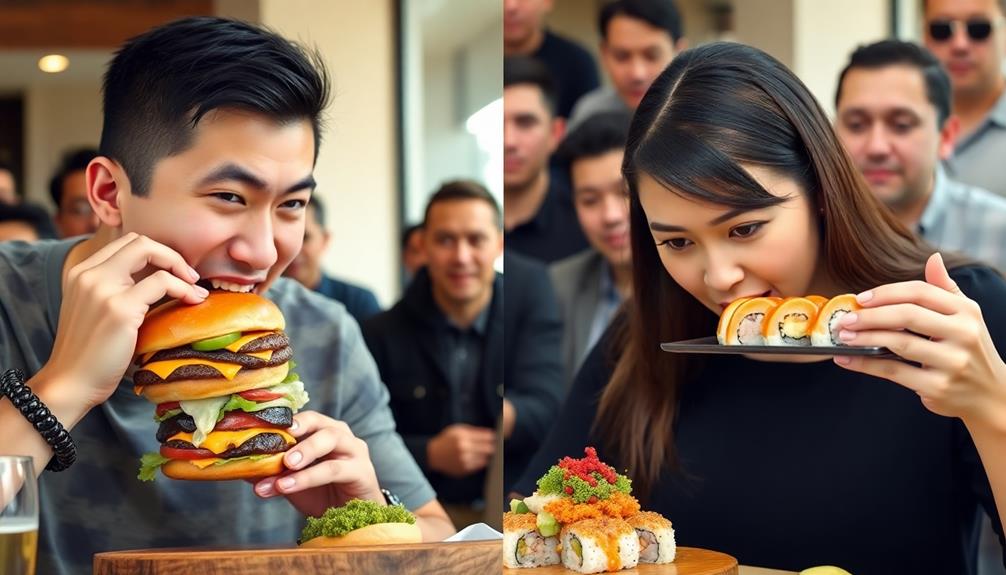
Gender dynamics play a pivotal role in the domain of competitive eating, shaping how male and female participants approach and experience these events. Research shows that male competitors often consume notably more food than female participants, with averages of 26.8 wings for men versus 14.5 for women. This discrepancy highlights the influence of social dynamics on consumption behaviors.
Much like Southern comfort food that often brings people together, competitive eating reflects the cultural significance of food and community, impacting how different genders engage in these competitions.
Here are three key aspects of gender dynamics in competitive eating:
- Social Pressure: Male competitors thrive in environments where cheering spectators boost their consumption. In contrast, female participants may feel self-conscious, leading to decreased food intake when watched.
- Emotional Experiences: While male eaters describe competitions as "challenging" and "exhilarating," many female participants report negative emotions, especially in spectator settings, which can diminish their enjoyment.
- Cultural Expectations: Traditional notions of masculinity encourage male competitors to push limits, while societal norms often pressure female participants to conform to more restrained consumption behaviors.
These factors underscore how gender dynamics not only affect individual experiences but also reflect broader societal perceptions within competitive eating events.
Future Trends in Competitive Eating
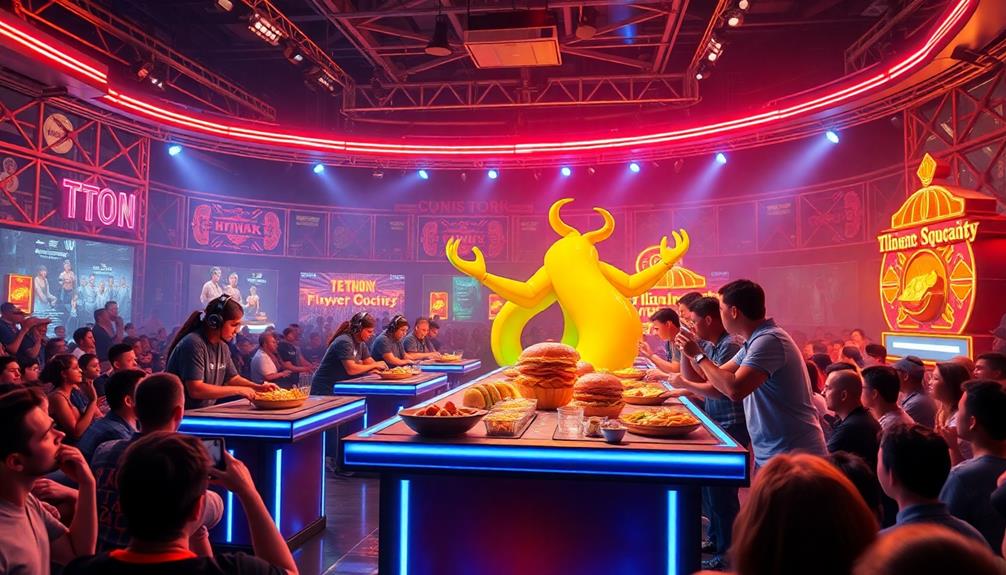
Increasingly, competitive eating is gaining traction as a mainstream activity, reflecting society's growing fascination with food challenges and consumption spectacles. Organizations like Major League Eating (MLE) and the International Federation of Competitive Eating (IFOCE) now oversee 70-80 contests annually, showcasing events such as the iconic Nathan's Hot Dog Contest, which draws over 40,000 spectators.
This surge in popularity isn't just random; it's driven by a blend of psychological motivations, social dynamics, and cultural trends. The appeal of food-centric competitions can also be seen in the enjoyment of classic American diner dishes like Loaded Baked Potato and Chicken Wings, which often feature in these contests.
As new food challenges and event formats emerge, you might notice a shift in how competitive eating is perceived. Video games and documentaries have further embedded this sport in popular culture, potentially leading to increased participation and sponsorship opportunities.
However, as competitive eating evolves, it also raises significant discussions about health risks and dietary habits. Future research will likely focus on the psychological motivations behind why individuals participate in competitive eating, exploring how social dynamics influence consumption behaviors across different demographics.
As you engage with this growing phenomenon, consider both the excitement and the implications it brings to food consumption and health consciousness.
Ethical Considerations and Food Waste
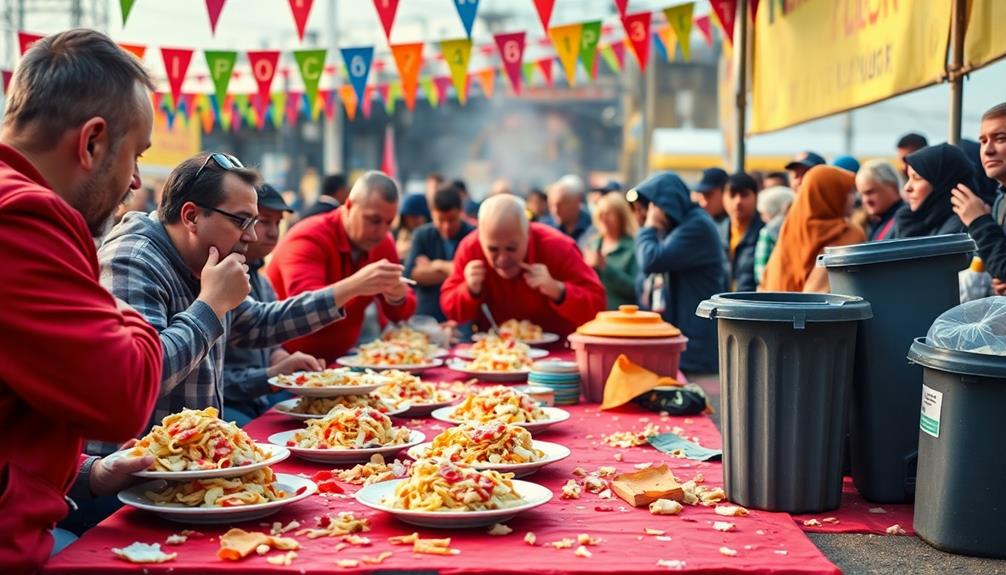
Raising awareness about the ethical implications of competitive eating can help shine a light on the food waste generated by these events. While you might enjoy watching spectacles like Nathan's Hot Dog Eating Contest, consider the consequences of promoting overconsumption.
Traditional dishes, such as Kue Putu, are often made with care and cultural significance, which highlights the value of food beyond mere consumption. The food waste produced raises significant ethical considerations, as many people around the world face food insecurity.
Here are three key points to think about:
- Cultural Norms: Competitive eating glamorizes overconsumption, influencing societal views on food waste and what's deemed acceptable.
- Moral Values: Events centered around excessive eating challenge our values regarding sustainability and responsible food practices, especially when so many struggle with hunger.
- Health Risks: The focus on entertainment often overlooks the long-term health implications for participants, raising questions about the responsibility of organizers and spectators alike.
In a world grappling with resource management, it's essential to rethink the ethics of competitive eating. By engaging in discussions about food waste and sustainability, you can contribute to a culture that values responsible consumption rather than excess.
Frequently Asked Questions
Is Competitive Eating an American Thing?
Yes, competitive eating is an American thing. It originated with events like the Nathan's Hot Dog Contest, reflecting cultural values of excess and entertainment. You'll see it celebrated widely, showcasing unique culinary challenges across the nation.
How Does Competitive Eating Work?
Competitive eating involves participants training to expand their stomach capacity, following strict rules during organized contests. You'll see competitors consume massive amounts of food within time limits, often influenced by the cheering crowd around them.
What Are the Cons of Competitive Eating?
You might think competitive eating's all fun and games, but it's not. It can lead to serious health risks, promote unhealthy habits, and create ethical dilemmas about food waste. It's a risky endeavor, to say the least.
How to Eat Like a Competitive Eater?
To eat like a competitive eater, practice timed sessions with large quantities, use techniques like food dunking, and stay hydrated. Train regularly, focus on speed, and visualize your success to enhance performance during contests.
Conclusion
In exploring the psychology of competitive eating, you'll find it mirrors our society's relationship with food and excess. Did you know that the average professional competitive eater consumes over 20,000 calories in a single event? This staggering number highlights not just individual prowess but also raises questions about health and sustainability. As competitive eating evolves, it's vital to contemplate its cultural significance and the ethical implications of such extreme consumption. The conversation around food waste and nutrition is more important than ever.
